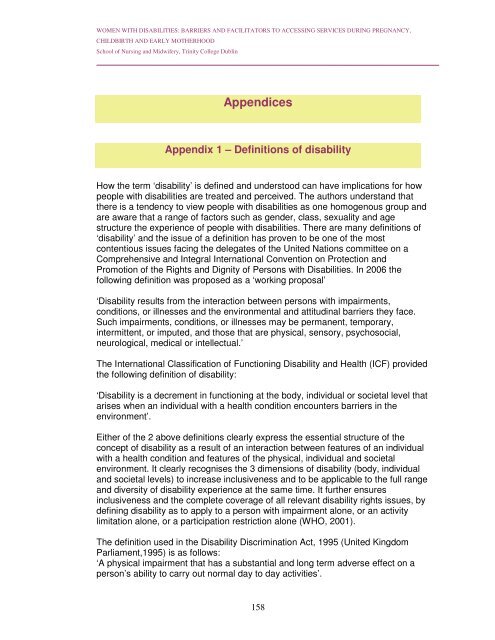Women with Disabilities: Barriers and Facilitators to Accessing ...
Women with Disabilities: Barriers and Facilitators to Accessing ...
Women with Disabilities: Barriers and Facilitators to Accessing ...
You also want an ePaper? Increase the reach of your titles
YUMPU automatically turns print PDFs into web optimized ePapers that Google loves.
WOMEN WITH DISABILITIES: BARRIERS AND FACILITATORS TO ACCESSING SERVICES DURING PREGNANCY,CHILDBIRTH AND EARLY MOTHERHOODSchool of Nursing <strong>and</strong> Midwifery, Trinity College DublinAppendicesAppendix 1 – Definitions of disabilityHow the term ‘disability’ is defined <strong>and</strong> unders<strong>to</strong>od can have implications for howpeople <strong>with</strong> disabilities are treated <strong>and</strong> perceived. The authors underst<strong>and</strong> thatthere is a tendency <strong>to</strong> view people <strong>with</strong> disabilities as one homogenous group <strong>and</strong>are aware that a range of fac<strong>to</strong>rs such as gender, class, sexuality <strong>and</strong> agestructure the experience of people <strong>with</strong> disabilities. There are many definitions of‘disability’ <strong>and</strong> the issue of a definition has proven <strong>to</strong> be one of the mostcontentious issues facing the delegates of the United Nations committee on aComprehensive <strong>and</strong> Integral International Convention on Protection <strong>and</strong>Promotion of the Rights <strong>and</strong> Dignity of Persons <strong>with</strong> <strong>Disabilities</strong>. In 2006 thefollowing definition was proposed as a ‘working proposal’‘Disability results from the interaction between persons <strong>with</strong> impairments,conditions, or illnesses <strong>and</strong> the environmental <strong>and</strong> attitudinal barriers they face.Such impairments, conditions, or illnesses may be permanent, temporary,intermittent, or imputed, <strong>and</strong> those that are physical, sensory, psychosocial,neurological, medical or intellectual.’The International Classification of Functioning Disability <strong>and</strong> Health (ICF) providedthe following definition of disability:‘Disability is a decrement in functioning at the body, individual or societal level thatarises when an individual <strong>with</strong> a health condition encounters barriers in theenvironment’.Either of the 2 above definitions clearly express the essential structure of theconcept of disability as a result of an interaction between features of an individual<strong>with</strong> a health condition <strong>and</strong> features of the physical, individual <strong>and</strong> societalenvironment. It clearly recognises the 3 dimensions of disability (body, individual<strong>and</strong> societal levels) <strong>to</strong> increase inclusiveness <strong>and</strong> <strong>to</strong> be applicable <strong>to</strong> the full range<strong>and</strong> diversity of disability experience at the same time. It further ensuresinclusiveness <strong>and</strong> the complete coverage of all relevant disability rights issues, bydefining disability as <strong>to</strong> apply <strong>to</strong> a person <strong>with</strong> impairment alone, or an activitylimitation alone, or a participation restriction alone (WHO, 2001).The definition used in the Disability Discrimination Act, 1995 (United KingdomParliament,1995) is as follows:‘A physical impairment that has a substantial <strong>and</strong> long term adverse effect on aperson’s ability <strong>to</strong> carry out normal day <strong>to</strong> day activities’.158
















